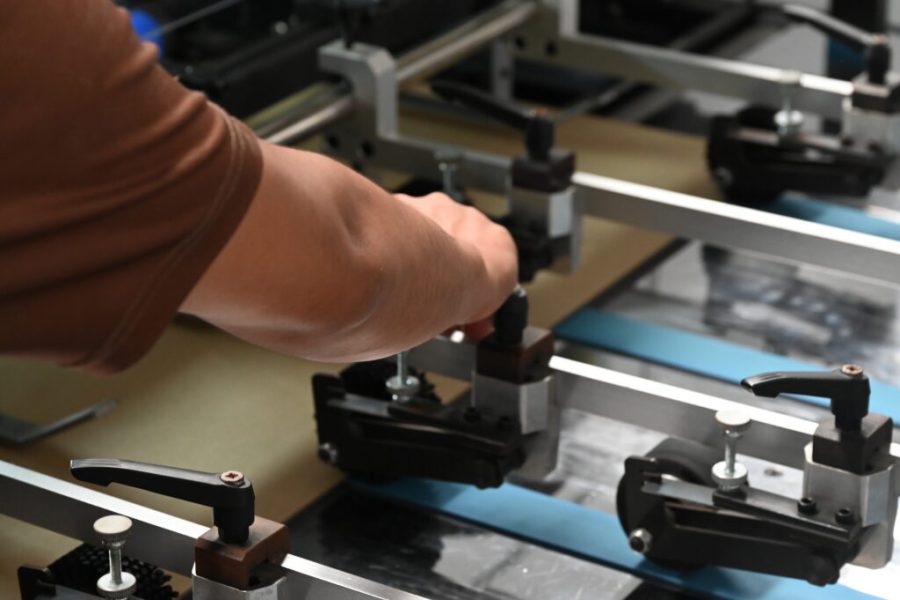Corrugated die cutting machines are an essential part of the packaging and manufacturing industry, known for their ability to produce precise and high-quality cuts in corrugated materials. These machines are designed to handle a wide range of cutting needs, from simple shapes to complex designs, making them indispensable for businesses involved in packaging, product displays, shipping corrugated die cutting machine and more. In today’s market, where customization, efficiency, and quality are key to success, corrugated die cutting machines provide a versatile solution to meet various production demands.
In this article, we’ll explore what corrugated die cutting machines are, their different types, their importance in the industry, how they function, and the considerations for choosing the right machine for your business. We’ll also examine leading manufacturers and suppliers of corrugated die cutting machines and provide insight into the future trends and innovations in this space.
Understanding Corrugated Die Cutting Machines
A corrugated die cutting machine is a specialized tool used to cut and shape corrugated board, a material commonly used in packaging. Corrugated board, made up of multiple layers of paper with a fluted or “corrugated” middle layer, is highly durable and widely used for producing shipping boxes, product packaging, and protective inserts.
Die cutting machines use a die—a specially crafted tool made from steel, rubber, or other durable materials—to stamp, cut, or shape materials into desired forms. In the context of corrugated materials, die cutting machines allow manufacturers to create custom packaging designs, intricate shapes, perforations, creases, and folds with high precision and consistency.
Key Features of Corrugated Die Cutting Machines:
Precision Cutting: These machines ensure accurate cuts, creating consistent products that meet design specifications and quality standards.
Customization: Custom dies enable businesses to create unique shapes and designs tailored to specific products or brands.
High-Speed Production: Modern corrugated die cutting machines are designed to handle large volumes of material, allowing for fast, efficient production runs.
Versatility: Capable of handling different types of corrugated board, from single-wall to triple-wall, as well as other materials like paperboard and cardstock.
Automation: Many machines come with automated feeding, cutting, and stacking systems, reducing manual labor and increasing efficiency.
Importance of Die Cutting in Corrugated Packaging
Corrugated packaging is one of the most widely used packaging materials across industries due to its durability, lightweight properties, and cost-effectiveness. The versatility of corrugated packaging makes it ideal for everything from shipping containers and retail packaging to display stands and protective inserts. Die cutting enhances the functionality and appeal of corrugated packaging by allowing for the creation of unique, brand-specific designs.
Die cutting is particularly important in the packaging industry for several reasons:
Customization: Brands can create bespoke packaging solutions that reflect their identity, differentiate them from competitors, and enhance the customer experience.
Functionality: Die cutting ensures that boxes, inserts, and displays are not only aesthetically pleasing but also functional. For example, die cuts can create precise slots for product placement, handles for easy transport, or perforations for easy opening.
Cost Efficiency: By maximizing material usage and minimizing waste, die cutting helps manufacturers reduce costs while producing high-quality packaging.
Sustainability: Corrugated board is recyclable and eco-friendly, and the precision of die cutting minimizes excess material, supporting sustainable manufacturing practices.
Types of Corrugated Die Cutting Machines
There are several types of corrugated die cutting machines, each suited to different production needs, material properties, and design complexity. Understanding these machines’ differences is key to selecting the right one for your business.
1. Flatbed Die Cutting Machines
Flatbed die cutting machines are one of the most common types used in the corrugated industry. These machines utilize a flat die that presses down onto the material to cut it into the desired shape. They are best suited for thicker materials like corrugated board, as they provide high precision and can handle intricate designs.
Advantages of Flatbed Die Cutters:
High precision in cutting complex shapes and designs.
Ideal for low to medium production volumes.
Can handle thicker materials, including multi-layered corrugated board.
Suitable for creating detailed creases, folds, and perforations.
Applications: Flatbed die cutting machines are often used in producing high-quality packaging for retail products, custom boxes, and displays that require intricate detailing.
2. Rotary Die Cutting Machines
Rotary die cutting machines use cylindrical dies that rotate as the material passes through, cutting shapes with high speed and efficiency. This type of machine is typically used in large-scale production environments where speed is a priority.
Advantages of Rotary Die Cutters:
High-speed production, making it ideal for large-scale operations.
Continuous feed system ensures efficiency and reduced downtime.
Capable of handling a wide range of materials, from single-wall to multi-wall corrugated board.
Applications: Rotary die cutters are widely used in the production of shipping containers, corrugated boxes, and high-volume packaging solutions. They are ideal for mass production, where speed and consistency are crucial.
3. Laser Die Cutting Machines
Laser die cutting is a more modern method that uses laser technology to cut corrugated materials without the need for physical dies. Instead of using a steel die, a focused laser beam cuts through the material, providing a high level of precision and flexibility.
Advantages of Laser Die Cutters:
No need for physical dies, which reduces setup time and costs.
Extremely precise cuts, making it ideal for detailed and intricate designs.
Flexibility in design changes without the need for new dies.
Suitable for short runs and prototypes where design flexibility is essential.
Applications: Laser die cutting is commonly used for custom packaging, prototypes, and smaller production runs that require a high degree of customization and intricate detailing.
4. Digital Die Cutting Machines
Digital die cutting machines are computer-controlled systems that allow for cutting, scoring, and creasing without the need for traditional dies. They are highly flexible and are ideal for businesses that require frequent design changes or small production runs.
Advantages of Digital Die Cutters:
No physical dies required, allowing for fast design changes.
Perfect for prototyping, short-run production, and custom orders.
Can handle various materials, including corrugated board, cardstock, and more.
Cost-effective for low-volume production.
Applications: Digital die cutting is widely used in packaging design studios, marketing companies, and smaller manufacturing businesses that need flexibility in design and production.
How Corrugated Die Cutting Machines Work
The basic working principle of a corrugated die cutting machine involves feeding the material into the machine, cutting or creasing it according to the die’s design, and then outputting the finished product. While the specific process varies depending on the machine type, the general workflow includes:
1. Feeding
The corrugated board is fed into the machine, either manually or automatically, depending on the level of automation. Some machines use a continuous feed system to ensure uninterrupted production, while others may have a batch-based process for smaller runs.
2. Cutting
Once the material is positioned, the die (or laser in the case of laser die cutters) comes into contact with the corrugated board to cut, crease, or score it. The die’s shape dictates the final cut or form, which is pre-designed to match the desired output.
3. Stripping
After the die cutting process, the machine strips away excess material, leaving behind the finished product in its final form. This step is essential for creating clean, accurate cuts and ensuring that the product is ready for the next stage in the production process.
4. Stacking and Delivery
The finished products are then automatically or manually stacked and delivered, ready for further processing, assembly, or shipping. High-end machines come equipped with automatic stacking systems that streamline this process and reduce manual handling.
Factors to Consider When Choosing a Corrugated Die Cutting Machine
When investing in a corrugated die cutting machine, several factors should be considered to ensure that the equipment meets your production needs and long-term goals. Here are some key considerations:
1. Production Volume
Understanding your production volume is critical in choosing the right machine. For high-volume production, rotary die cutters offer the speed and efficiency needed to meet demand, while flatbed or laser cutters may be better suited for smaller, more intricate production runs.
2. Material Thickness
The thickness of the corrugated board you work with will affect the type of machine you need. Flatbed die cutters are often better for thicker, multi-layered corrugated boards, while rotary die cutters excel with thinner materials in large quantities.
3. Design Complexity
For businesses that require intricate designs or custom packaging, precision is key. In these cases, flatbed or laser die cutting machines may be the best option, as they offer the highest level of accuracy.
4. Flexibility and Customization
If your business involves frequent design changes or customization, digital or laser die cutting machines offer the flexibility to adapt without needing new dies. These machines are ideal for short production runs, prototypes, and custom orders.
5. Automation and Efficiency
The level of automation you need depends on your business size and production goals. Fully automated die cutting machines can significantly reduce labor costs and increase efficiency by streamlining feeding, cutting, and stacking processes.
6. Budget and ROI
While the initial investment in a corrugated die cutting machine can be significant, it’s important to weigh the cost against the long-term benefits. Higher-end machines may offer faster production times, better precision, and more customization options, ultimately providing a better return on investment.
Leading Manufacturers and Suppliers of Corrugated Die Cutting Machines
Several manufacturers are known for producing high-quality corrugated die cutting machines, catering to various industries and production needs. Some of the top companies include:
1. Bobst Group
Bobst is one of the leading manufacturers of die cutting machines, known for their precision, innovation, and reliability. They offer a wide range of machines, including flatbed and rotary die cutters, designed specifically for corrugated packaging production.
2. Heidelberg
Heidelberg is another major player in the die cutting industry, providing a range of machines that cater to the packaging and printing sectors. Their machines are known for their high precision and ability to handle complex designs and large production volumes.
3. Young Shin Machinery
Young Shin Machinery specializes in producing automatic die cutting machines for the corrugated and paperboard industries. Their machines are known for their reliability, precision, and ability to handle various materials.
4. Kongsberg PCS
Kongsberg PCS is a leading provider of digital die cutting solutions, offering machines that cater to the packaging, signage, and display industries. Their machines are known for their flexibility, customization options, and ability to handle complex designs.
5. Eterna Machinery
Eterna Machinery, a subsidiary of Bobst Group, offers high-quality flatbed die cutting machines for the corrugated packaging industry. Their machines are widely used in the production of corrugated boxes, displays, and other packaging products.
The Future of Corrugated Die Cutting: Trends and Innovations
As technology continues to evolve, the corrugated die cutting industry is seeing several exciting trends and innovations that promise to enhance production capabilities and meet the growing demand for sustainable, high-quality packaging solutions.
1. Automation and Smart Technology
Automation is becoming increasingly important in the die cutting industry, with more machines incorporating advanced features like automated feeding, stacking, and stripping systems. Smart technology, including IoT (Internet of Things) integration, allows machines to communicate and optimize performance in real-time, reducing downtime and improving efficiency.
2. Sustainability
As sustainability becomes a key concern for businesses and consumers, manufacturers are focusing on developing eco-friendly die cutting solutions. This includes reducing material waste, using recyclable materials, and optimizing production processes to minimize energy consumption.
3. Digital and Laser Cutting
Digital and laser cutting technologies are gaining popularity due to their flexibility and precision. These machines allow for rapid prototyping, customization, and design changes without the need for traditional dies, making them ideal for industries that require fast turnaround times and high levels of customization.
4. Improved Material Handling
Innovations in material handling are helping businesses reduce waste, improve accuracy, and streamline production processes. For example, advanced feeding systems can handle multiple materials simultaneously, while cutting-edge stripping technologies ensure clean, precise cuts with minimal excess material.
Conclusion
Corrugated die cutting machines are a cornerstone of the packaging and manufacturing industries, offering businesses the ability to produce high-quality, custom-designed products with efficiency and precision. Whether you’re producing shipping containers, retail packaging, or product displays, investing in the right die cutting machine can significantly enhance your production capabilities and help you stay corrugated die cutting machine in today’s fast-paced market.
By understanding the different types of machines, their applications, and the factors to consider when choosing a machine, you can make informed decisions that align with your business needs. With the right corrugated die cutting machine, you can streamline production, reduce costs, and create packaging that stands out from the competition.
As the industry continues to evolve, embracing new technologies like automation, digital cutting, and sustainable manufacturing practices will ensure that your business remains at the forefront of innovation.





